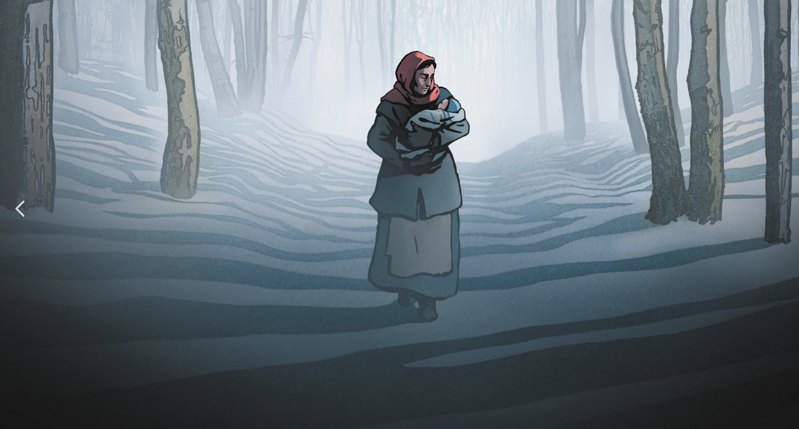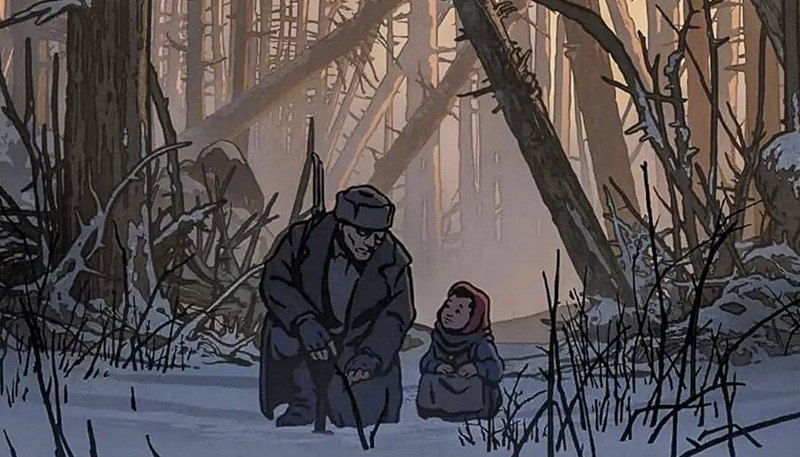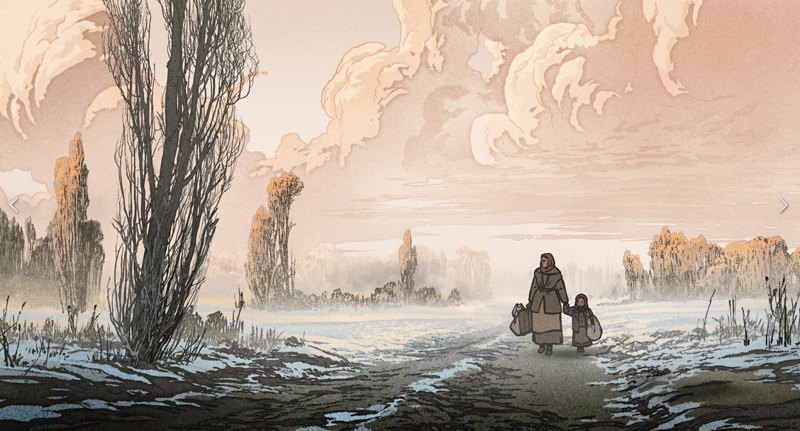Michel Hazanavicius is a truly unique director his style is, essentially, the absence of one.
Having embraced stylisation as his main creative tool, he crafts brilliant comedies, both intellectual and satirical. OSS 117: Cairo, Nest of Spies (2006) and OSS 117: Lost in Rio (2009) are cheeky spoofs of the never-ending James Bond saga; Redoubtable (2017) playfully mimics the complex style of cinema icon Jean-Luc Godard to tell the story of his relationship with actress and muse Anna Karina; Final Cut (Coupez!, 2022) is a tongue-in-cheek zombie horror parody; and of course The Artist (2011), which earned Hazanavicius an Academy Award for Best Director a flawless homage to silent cinema.
In The Most Precious of Cargoes, Hazanavicius stays true to his “try-everything-once” method this is his first animated feature. The screenplay is based on a fairy tale, and the story begins just like one: “Once upon a time, deep in a forest lived a poor Woodcutter and his wife…”
The opening shot? A snow-covered forest framed like an ornate illustration from a classic children’s book.

This fairy-tale tone weaves through the first half of the story, and for a while, the plot feels almost mythological. The Woodcutter’s wife, having lost her child, prays daily to the gods of the train that keeps thundering through the forest until one day, she finds a baby lying in the snow, wrapped in cloth with a strange, unfamiliar pattern.
She takes the child home, but the Woodcutter calls the little girl “one of the Heartless.”
Meanwhile, the trains keep coming, and slowly it becomes clear that these are no gods at all but men with ruthless wills, transporting Jews to death camps.
Even as the story grows darker, its fairy-tale quality lingers. Birds and woodland creatures appear as silent witnesses to human suffering and cruelty. The train itself transforms from a sleek symbol of modernity into a thunderous demon piercing through a frozen void, hurtling straight toward the gates of hell.
Eventually, Hazanavicius dares to peer into that hell: mass graves in Auschwitz, glimpsed in a few haunting, expressionist-style frames.
Not once do we hear the words “Jews,” “Holocaust,” or “concentration camp.”
Everything is drawn, everything is shown the director drew inspiration, in part, from the 19th-century Japanese printmaker Utagawa Hiroshige including the savagery of the so-called Soviet “liberators,” one of whom executes an old man caring for the Woodcutter’s wife and the child after the Woodcutter’s death.

By the way, it is worth noting that Azanavicius is equally close to the fate of the Jewish and Ukrainian peoples: he was born into a Jewish family, and his grandmother is from Kovel. Azanavicius supports the soldiers of the Ukrainian Armed Forces; he came to Kyiv for the launch of the Ukrainian distribution of The Most Precious of Cargoes, and this was his sixth visit to Ukraine. There is a scene in the film that caused the audience to laugh out loud: A woodcutter is arguing with a group of anti-Semites, and one of them has a physiognomic resemblance to Putin.
Although the subject matter is terrible, Azanavicius has created a surprisingly warm, even sentimental tale about the power of love. A beautiful and precise reminder of the Shoah, all the more appropriate now.

Michel Azanavicius:
‘My producer gave me a book by Jean-Claude Grumbert called The Most Precious of Cargoes. When I read it, I was deeply impressed by this story, which is simple but very powerful. I can say that this film chose me, and not I chose it.
The decision to make the film in animation was obvious. It is very difficult to represent the Holocaust, very difficult to film and talk about trains with people deported to concentration camps. Animation allowed us not to be tied to realism. We wanted to tell, show, and hint at what was happening. And we had to do exactly that, because the film is also addressed to children. They cannot be shown the horrors of the Holocaust directly, directly, cruelly, because there is a risk of traumatising them. We didn't want to lie to them and at the same time we didn't want to traumatise them.

I have been drawing since I was 10 years old, so I did the basic drawings [for the film], came up with the characters, but I couldn't work on the animation. That's why the animation team and I were looking for a way to animate the characters, a style. When I read the book, I got the impression that it was classic literature. So I wanted to convey this feeling of classical literature, so I was inspired by nineteenth-century French painting and Japanese prints of the time, in particular the graphics of Utagawa Hiroshige, to make the image look like old illustrations. This allowed us to create an animated film with this classic spirit.
In my opinion, it's very difficult to determine the time distance from which such horrors can be shown. Especially the horrors that are happening now. Even if we're talking about the Holocaust, for many, many years it was impossible to distance ourselves enough to make a film or a performance about it. Visual works about the Catastrophe began to be created not so long ago, I think, when the survivors had already begun to leave this world. But our attempts to tell some parts of this story are already some kind of achievement. We are trying to tell it only now.’








